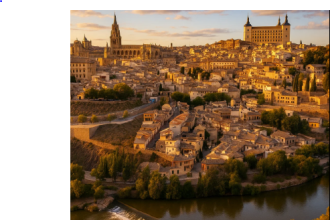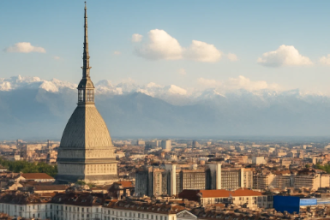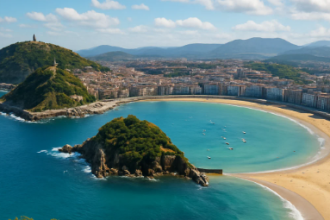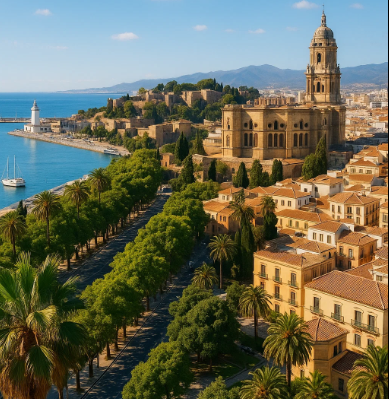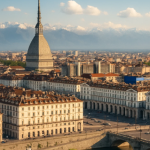Málaga hit me like a burst of sunshine. I’d planned a quick visit, but this Andalusian city grabbed me with its sandy beaches, old streets, and that laid-back vibe that makes you want to linger. My first afternoon, sipping a cold beer by the sea with the scent of grilled sardines in the air, I knew I was in for something special. For European travellers hunting for a mix of history, culture, and Mediterranean charm, Málaga’s your spot. Here’s how it won me over and why it’ll probably do the same for you.
Why Málaga Feels Like a Warm Welcome
I didn’t expect Málaga to feel so easy, like slipping into a favorite pair of jeans. It’s got ancient forts, lively tapas bars, and the sea right there, sparkling like it’s showing off. Getting here’s no hassle—budget flights from London, Berlin, or Paris land at Málaga-Costa del Sol Airport, just a 15-minute ride to the centre. Trains from Madrid or Seville roll through gorgeous countryside too. I went in autumn, when the days were warm and the nights had a soft chill, but spring’s just as good, and winter’s sunny days are a treat for escaping the cold. Málaga’s small enough to wander, but every corner’s got a little magic waiting.
The Alcazaba: A Glimpse of Another Time
My first morning, I headed to the Alcazaba, a Moorish fortress perched above the city. Walking through its courtyards, with orange trees and carved arches all around, felt like I’d wandered into an old story. The view from the top—rooftops tumbling toward the port and the sea stretching out—made me stop and just stare. I swung by the Gibralfaro Castle next, a short hike up, for even better views, especially when the sun dipped and turned everything golden. I grabbed a combo ticket for both and went early to beat the heat. It’s the kind of place that makes history feel alive, like you’re walking through it.
Old Town: Where Málaga Comes Alive
Málaga’s Old Town is where I lost myself, and I didn’t mind one bit. Narrow streets wind past buildings painted in soft pinks and yellows, opening onto squares buzzing with chatter. I stopped at the Catedral de Málaga, called La Manquita for its missing tower, and gaped at its huge, golden interior. Calle Larios is the fancy shopping street, but I liked poking around the side alleys, finding tiny shops and cafés with wobbly tables. One afternoon, I plopped down in Plaza de la Constitución with a coffee, watching a guitarist strum and kids chase each other. It’s the kind of place where you forget your to-do list and just soak it up.
Beaches and Seafront Bliss
Málaga’s beaches are where I let my worries float away. Playa de la Malagueta was my go-to, just a hop from the centre, with soft sand and calm waves. I grabbed lunch at a chiringuito, scarfing down espeto—sardines grilled on sticks over a fire—while my toes dug into the sand. The Muelle Uno waterfront is perfect for an evening walk, with bars, shops, and the funky Centre Pompidou Málaga, a bright art museum that’s as cool as it looks. Whether I was napping under an umbrella or sipping sangria by the water, Málaga’s coast felt like a little slice of paradise.
Food That’s a Party
Málaga’s food is pure joy. I spent an evening hopping tapas bars in the Old Town, my table filling up with gambas al pil-pil—prawns swimming in garlicky oil—and albóndigas, meatballs so tender they melted. Some spots toss in free tapas with your drink, and I ended up with a feast for pennies. Mornings meant churros con chocolate at a dive near Plaza de la Merced—crispy sticks dunked in thick, sweet cocoa. The Mercado de Atarazanas was my daily stop for juicy figs, slices of jamón, and handfuls of almonds. A glass of sweet Málaga wine or a cold Cruzcampo sealed the deal every time.
Culture and Picasso’s Roots
Málaga’s got a creative pulse, and it’s proud of Pablo Picasso, its hometown hero. I wandered through the Museo Picasso Málaga, set in an old palace, and got lost in his wild paintings—I didn’t know he was born here till I saw it. The Casa Natal de Picasso, his childhood home, is smaller but feels like a peek into his life, with old sketches and photos. The Museo Carmen Thyssen Málaga hooked me with its Spanish art, all dramatic and colorful. If you’re here in August, the Feria de Málaga takes over—think flamenco, street dances, and enough energy to keep you up till dawn. Málaga’s always got something going on.
Practical Tips for Your Málaga Trip
- When to Go: April–May or September–October for sunny days and quieter streets. Summer’s hot but buzzing; winter’s mild and bright.
- Getting There: Fly to Málaga-Costa del Sol (15 minutes from downtown) from major European cities. Trains from Madrid or Seville are easy and scenic.
- Getting Around: Walk the Old Town—it’s small and gorgeous. Buses or taxis for farther spots; bikes are fun along the promenade.
- Where to Stay: Old Town for history and nightlife, El Palo for beachy vibes, or Soho for artsy cafés.
- My Tip: Pack sunscreen and shoes you can walk in. A quick “hola” with a grin makes locals light up.
Why Málaga Sticks With You
Málaga’s more than a city—it’s a mood. It’s the taste of sardines fresh off the grill, the glow of old stones at sunset, the clink of glasses in a noisy plaza. It’s where history and beach days collide, where every tapas bar feels like a friend’s place, and every view makes you pause. For European travellers after a spot that’s easy to get to and tough to leave, Málaga’s calling. Grab your shades, roam its sunny streets, and let this Andalusian gem spark some joy in your soul.

